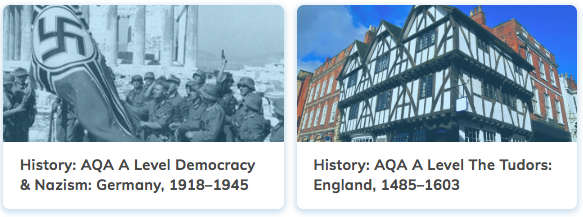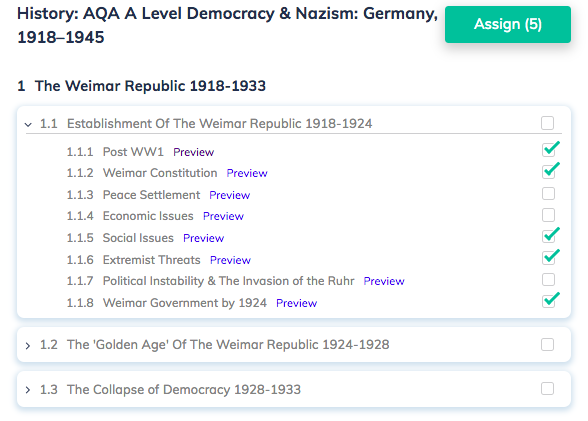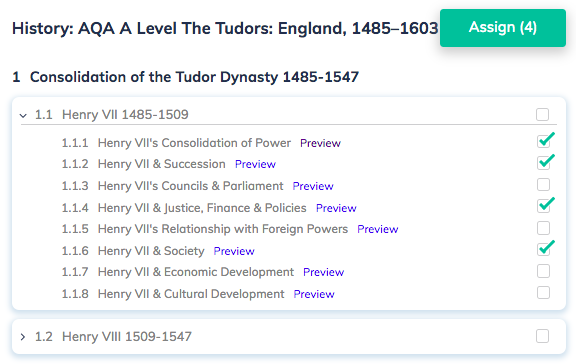

The A Level History Primer for Teachers
This A Level AQA History primer describes the content of Seneca's revision courses, so that you can easily incorporate homework assignments on Seneca into your teaching plan. If you're a history teacher you can use Seneca to set homework in under 15 seconds, whilst also also benefitting from automated marketing & revision insights. That way, you can easily see which sections need more attention next lesson!

Vital Resources for You:
- The Seneca Teacher platform
- AQA teaching resources
- AQA Past papers and mark schemes
- AQA Scheme of Assessment
Setting A Level History Homework on Seneca
- Seneca & its teacher platform are free to use (including automated marking!)
- All revision courses are written by examiners and subject experts to ensure the content matches the exact exam board specifications.
- Seneca is really engaging - many students study more often & for longer periods of time. 
Curriculum: History: AQA A Level Democracy & Nazism: Germany, 1918–1945
1 The Weimar Republic 1918-1933
1.1 Establishment Of The Weimar Republic 1918-1924
1.1.1 Post WW1
1.1.2 Weimar Constitution
1.1.3 Peace Settlement
1.1.4 Economic Issues
1.1.5 Social Issues
1.1.6 Extremist Threats
1.1.7 Political Instability & The Invasion of the Ruhr
1.1.8 Weimar Government by 1924
1.2 The 'Golden Age' Of The Weimar Republic 1924-1928
1.2.1 Economic Developments
1.2.2 Industry & Agriculture
1.2.3 Social Developments
1.2.4 Political Parties
1.2.5 Political Stability
1.2.6 Germany's International Position
1.3 The Collapse of Democracy 1928-1933
1.3.1 The Impact Of The Depression
1.3.2 Politics After The Depression
1.3.3 The Appeal Of Extremism
1.3.4 'Backstairs Intrigue'
1.3.5 Political Developments
1.3.6 The State by March 1933
2 Nazi Germany 1933-1945
2.1 The Nazi Dictatorship 1933-1939
2.1.1 Hitler's Consolidation Of Power
2.1.2 The Terror State
2.1.3 Opposition
2.1.4 Economic Policies
2.1.5 Impact Of Economic Policies
2.1.6 Social Policies
2.1.7 Volksgemeinschaft
2.2 The Racial State 1933-1941
2.2.1 The Radicalisation Of The State
2.2.2 Anti-Semitism
2.2.3 Development Of Anti-Semitic Policies
2.2.4 Treatment of the Jews in the Early Years of War
2.3 The Impact Of War 1939-1945
2.3.1 Home Front
2.3.2 Impact On Society
2.3.3 War Economy
2.3.4 Policies Towards The Jews & Untermenschen
2.3.5 Opposition
2.3.6 Nazi State by 1945

Curriculum: History: AQA A Level The Tudors: England, 1485–1603
1 Consolidation of the Tudor Dynasty 1485-1547
1.1 Henry VII 1485-1509
1.1.1 Henry VII's Consolidation of Power
1.1.2 Henry VII & Succession
1.1.3 Henry VII's Councils & Parliament
1.1.4 Henry VII & Justice, Finance & Policies
1.1.5 Henry VII's Relationship with Foreign Powers
1.1.6 Henry VII & Society
1.1.7 Henry VII & Economic Development
1.1.8 Henry VII & Cultural Development
1.2 Henry VIII 1509-1547
1.2.1 Henry VIII's Consolidation of Power
1.2.2 Henry VIII & His Government
1.2.3 Henry VIII & Succession
1.2.4 Henry VIII's Relationship with Foreign Powers
1.2.5 Henry VIII & Society
1.2.6 Henry VIII & Economic Development
1.2.7 Henry VIII & Religion
2 England: Turmoil & Triumph 1547-1603
2.1 Instability & Consolidation 1547-1563
2.1.1 Edward VI, Somerset & Northumberland
2.1.2 Edward VI & Authority
2.1.3 Edward VI & Relations with Foreign Powers
2.1.4 Edward VI & Rebellions
2.1.5 Social Impact of Religious & Economic Changes
2.1.6 Edward VI & Cultural Developments
2.1.7 Mary I & Her Rule
2.1.8 Mary I & Relations with Foreign Powers
2.1.9 The Social Impact of Religious & Economic Change
2.1.10 Elizabeth I & Her Rule
2.1.11 Elizabeth I & Relations With Foreign Powers
2.1.12 Impact of Economic, Social & Religious Change
2.2 The Triumph of Elizabeth 1563-1603
2.2.1 Elizabeth I & Court
2.2.2 Elizabeth & Government
2.2.3 Elizabeth I & Succession
2.2.4 Mary Queen of Scots
2.2.5 Relations with Spain
2.2.6 Elizabeth I & Society
2.2.7 Elizabeth I & Rebellion
2.2.8 Elizabeth & Economic Development
2.2.9 Elizabeth I & Religious Developments
2.2.10 The English Renaissance
2.2.11 Elizabeth's Last Years






